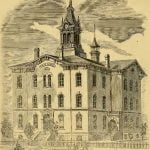This collection on the History of Douglas County Illinois currently contains 114 biographies on important people in the history of the county.
The open prairie country of Douglas County greatly retarded the settlement of this section of Coles County. A few came here previous to 1850, but the great bulk of the public lands was occupied by actual owners subsequent to that date. The first settlement in Coles County as originally formed was about 1824, and subsequent additions to the white population found homes at widely separated points, from the Cumberland Road on the south, to Camargo on the north. The original pioneer of Douglas County was John Richman, who, in 1829, settled in Camargo township. He was a native of Greenbrier County, West Virginia, and came with his father when a lad of sixteen years to Vermilion County, Illinois. The journey was made over the tedious roads of the frontier in wagons accompanied by a drove of sheep, horses and cattle. Here the family lived on and worked a rented farm for two or three years. In the meanwhile, the father, accompanied by a friend, made a visit to the Embarrass timber in quest of honey. Here in eight or ten days they secured several barrels of honey, and in the course of their rambles became so enamored with the country that Mr. Richman determined to remove to this region. In May of the following year, 1829, the family removed and took up their residence a mile and a half from the present site of Camargo village in the timber skirting the Embarrass River. At this time there was not another white family within the present limits of Douglass County, and none in Coles north of Charleston. For upward of a year the Richman’s lived in this solitude, when they were joined by Harrison Gill, and perhaps some six months later by Isaac Moss, who settled about a mile east of the present village of Camargo. The Indians were in the neighborhood for three years after the advent of these pioneers, their village occupying the present site of Bridgeport. The Indians came in the fall for hunting, and stayed through the winter, and in the spring went north to their cornfields. The first summer, the Richman’s lived in a temporary camp built of logs split in twain, while the male portion of the family devoted their efforts to breaking the prairie, and securing a harvest, but they soon found their team power inadequate for the undertaking and resorted to the timber. The work of clearing and putting in the crop consumed the time until the 10th of July, when they had the satisfaction of seeing fourteen acres planted in corn. Their next care was to provide a permanent shelter from the rigors of the winter. Logs were procured and partly hewed, when the grim terror of pioneer life, the ague, laid seven of the eleven members of. the family prostrate. For several months the family were obliged to give up further work on their improvements, and the winter found them still occupying the original cabin. On the following year the hewed-log house was finished and occupied, and still remains a landmark of the olden time.
History of Douglas County Illinois – Biographies
- Armstrong, A. A.
- Ashurst, Joseph
- Atwell, William E.
- Avery, J. L.
- Bailey, David, Captain
- Barnes, John C.
- Bassett, J. H.
- Bassett, W. H.
- Beggs, Jesse R.
- Black, Robert M.
- Blaine, Walter C.
- Boyce, Washington D.
- Boyer, J. W.
- Brian, William Sr.
- Brian, William T.
- Bright, Coleman
- Brock, George W.
- Brown, John, Judge
- Burgett, I. W.
- Burgett, Wilson S.
- Butler, J. T.
- Callaway, George
- Calvin, Edward W.
- Campbell, Allan
- Chandler, William B.
- Craddik, Thomas
- Cruzan, Thomas
- Ephlin, Jacob, Mr. and Mrs.
- Ervin, Samuel
- Fidler, Albert F.
- Fisher, William H.
- Gill, Harrison
- Gill, Shiloah
- Glassco, Kimball
- Goff, John L.
- Greve, C. D.
- Hammett, Frank W.
- Hammett, James R.
- Hammett, William S.
- Hance, Alexander
- Hancock, W. H.
- Hawkins, Charles A.
- Heaton, James P.
- Henson, George W.
- Henson, Spephen S.
- Hockett, Oliver O.
- Hopkins, Samuel L.
- Hostetler, John C.
- Howard, W. Avery
- Howe, James H.
- Irwin, John T.
- Jeffers, Emmor W.
- Jeffers, George C.
- Jones, Henry C.
- Jones, John J.
- Jones, Malden
- Jones, Owen E.
- Kimball, Glassco
- King, John W.
- Lester, Segler H.
- Lindsey, John
- Logan, Samuel B.
- Loose, Frank F.
- Madison, John M.
- Martin, J. V. Rev.
- McCarty, Francis A.
- McGown, J. A.
- McKaig, Robert
- McKinney, John Wright
- McMasters, Charles L.
- McNeill, Alexander
- Means, William E. Rev.
- Monahan, P. H.
- Monroe, N. S.
- Moore, Geo. O.
- Moore, Jacob
- Moore, Jacob R.
- Moser, George H.
- Mulliken, Ira M.
- Newport, William H.
- Outcelt, John N.
- Parke, Alvy J.
- Parker, Oliver H.
- Pepper, W. W.
- Petty, Joseph B.
- Phillips, J. W.
- Price, W. E.
- Pulliam, W. T., M. D.
- Reat, James L., M. D.
- Redden, Stephen
- Reed, W. D.
- Reeder, James S.
- Reeder, James S.
- Reeves, William W.
- Richards, G. R.
- Richards, T. M.
- Rigney, J. B., M. D.
- Roberts, Thomas W.
- Roderick, Daniel
- Skinner, Isaac
- Skinner, W. W.
- Sluss, A. C.
- Smiley, Samuel W.
- Swigart, T. W.
- Wallace, Albert W.
- Watson, Marion
- Watson, W. L.
- Whitaker, John
- White, George
- Williams, James A.
- Wilson, Charles W.
- Wiseman, William A.
- Wright, James H.
- Wyatt, Thomas S.

